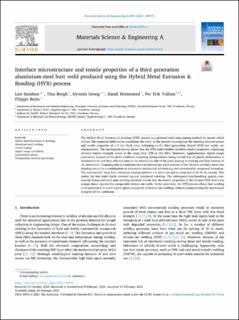| dc.contributor.author | Sandnes, Lise | |
| dc.contributor.author | Bergh, Tina | |
| dc.contributor.author | Grong, Øystein | |
| dc.contributor.author | Holmestad, Randi | |
| dc.contributor.author | Vullum, Per Erik | |
| dc.contributor.author | Berto, Filippo | |
| dc.date.accessioned | 2021-04-21T08:27:06Z | |
| dc.date.available | 2021-04-21T08:27:06Z | |
| dc.date.created | 2021-03-03T08:09:25Z | |
| dc.date.issued | 2021 | |
| dc.identifier.citation | Materials Science & Engineering: A. 2021, 809, . | en_US |
| dc.identifier.issn | 0921-5093 | |
| dc.identifier.uri | https://hdl.handle.net/11250/2738785 | |
| dc.description.abstract | The Hybrid Metal Extrusion & Bonding (HYB) process is a patented solid state joining method for metals which utilizes filler material additions to consolidate the weld. In the present investigation the interface microstructure and tensile properties of a 4 mm thick joint, belonging to the third generation Al-steel HYB butt welds, are characterized. The mechanical testing shows that the HYB weld exhibits excellent tensile properties, displaying ultimate tensile strength values in the range from 238 to 266 MPa. Moreover, supplementary digital image correlation analysis of the strain evolution occurring during tensile testing reveals that all plastic deformation is localized to the soft heat-affected zone on the aluminium side of the joint, leading to necking and final fracture in the aluminium. Scanning and transmission electron microscopy examinations of the Al-steel interface show that bonding occurs by a combination of microscale mechanical interlocking and intermetallic compound formation. The intermetallic layer has a thickness varying between 0.1 and 1 μm and is composed of Al–Fe–Si crystals. This makes the butt joint highly resistant against interfacial cracking. The subsequent benchmarking against commercial fusion and solid state welding methods reveals that the tensile properties of the Al-steel HYB weld even surpass those reported for comparable friction stir welds. At the same time, the HYB process allows butt welding to be performed at much higher speeds compared to friction stir welding, without compromising the mechanical integrity of the weldment. | en_US |
| dc.language.iso | eng | en_US |
| dc.publisher | Elsevier Science | en_US |
| dc.rights | Navngivelse 4.0 Internasjonal | * |
| dc.rights.uri | http://creativecommons.org/licenses/by/4.0/deed.no | * |
| dc.title | Interface Microstructure and Tensile Properties of a Third Generation Aluminium-Steel Butt Weld Produced Using the Hybrid Metal Extrusion & Bonding (HYB) Process | en_US |
| dc.type | Peer reviewed | en_US |
| dc.type | Journal article | en_US |
| dc.description.version | publishedVersion | en_US |
| dc.source.volume | 809 | en_US |
| dc.source.journal | Materials Science & Engineering: A | en_US |
| dc.identifier.doi | 10.1016/j.msea.2021.140975 | |
| dc.identifier.cristin | 1895115 | |
| dc.description.localcode | This is an open access article distributed under the terms of the Creative Commons CC-BY license, which permits unrestricted use, distribution, and reproduction in any medium, provided the original work is properly cited. | en_US |
| dc.source.articlenumber | 140975 | en_US |
| cristin.ispublished | true | |
| cristin.fulltext | original | |
| cristin.qualitycode | 2 | |

